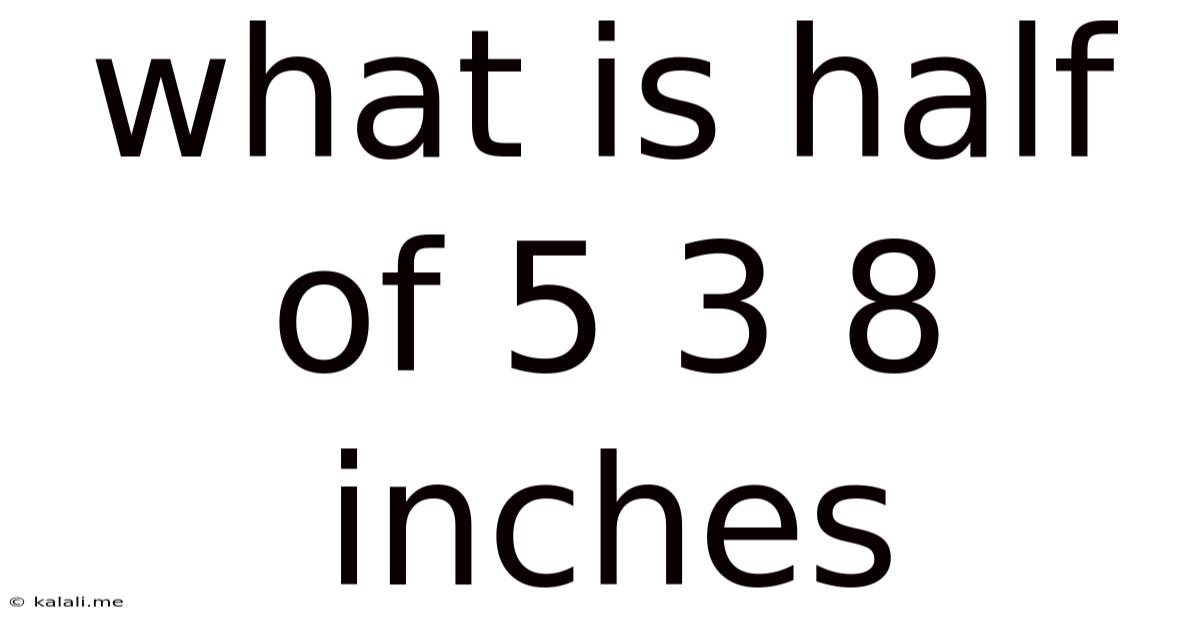What Is Half Of 5 3 8 Inches
Kalali
Jul 04, 2025 · 4 min read

Table of Contents
What is Half of 5 3/8 Inches? A Deep Dive into Fractions and Measurement
This seemingly simple question, "What is half of 5 3/8 inches?", opens a door to a deeper understanding of fractions, mixed numbers, and their practical applications in everyday measurements. While the answer itself is straightforward, the process of arriving at it provides valuable insight into fundamental mathematical concepts. This article will not only solve the problem but also explore the underlying principles, offering various methods and explaining the importance of accuracy in measurement. Understanding these concepts will be invaluable for anyone working with measurements, whether it's crafting, cooking, or engineering.
Understanding the Problem: Breaking Down the Mixed Number
The question presents us with a mixed number: 5 3/8 inches. A mixed number combines a whole number (5) and a fraction (3/8). To find half of this, we need to convert the mixed number into an improper fraction. This makes the calculation significantly easier.
Method 1: Converting to an Improper Fraction
- Multiply the whole number by the denominator: 5 x 8 = 40
- Add the numerator: 40 + 3 = 43
- Keep the same denominator: The denominator remains 8.
Therefore, 5 3/8 inches is equivalent to 43/8 inches.
Now, finding half is simple:
(43/8) / 2 = 43/16 inches
Method 2: Halving the Whole Number and the Fraction Separately
This method provides a more intuitive approach, especially for those less comfortable with improper fractions.
-
Half the whole number: Half of 5 inches is 2.5 inches.
-
Half the fraction: Half of 3/8 is (3/8) / 2 = 3/16 inches.
-
Combine the results: 2.5 inches + 3/16 inches = 2 11/16 inches (converting the decimal 0.5 to 8/16 and then adding 3/16) or approximately 2.6875 inches.
Reconciling the Results: Decimal Equivalents and Precision
Both methods should, and do, yield the same result. 43/16 inches is equivalent to 2.6875 inches. This highlights the importance of understanding the relationship between fractions and decimals in measurement. The choice of method depends on personal preference and the context of the problem. For many practical applications, rounding to a convenient decimal or fraction might be sufficient. For example, 2 11/16 inches could be rounded to 2 3/4 inches for easier handling.
The Importance of Accuracy in Measurement
The precision required in a measurement depends heavily on the application. In woodworking, for instance, an error of even 1/16th of an inch can significantly impact the final product. In contrast, measuring the length of a piece of string for a casual craft might not require such precision. Understanding the limitations of your measuring tools and the level of accuracy needed is crucial.
Exploring Further: Applications and Extensions
Understanding how to work with fractions and mixed numbers extends far beyond simple halving. Let's explore some related concepts and their applications:
- Calculating Percentages: If you need to find 25% of 5 3/8 inches, you would first find half (as we did above), then find half of that result.
- Adding and Subtracting Mixed Numbers: Imagine needing to add 5 3/8 inches to another measurement, such as 2 1/4 inches. You'd need to convert both to improper fractions or find a common denominator before performing the addition.
- Working with Different Units: Often, you might need to convert inches to centimeters or feet. Knowing the conversion factors (1 inch = 2.54 cm, 1 foot = 12 inches) is essential for accurate calculations.
- Applications in Various Fields: The ability to accurately work with fractions and measurements is vital in many fields, including carpentry, sewing, engineering, cooking, and even art.
Advanced Considerations: Error Propagation and Significant Figures
When working with multiple measurements, it's crucial to consider the concept of error propagation. Every measurement has a degree of uncertainty, and these uncertainties can accumulate during calculations. Understanding significant figures helps to express the accuracy of a measurement appropriately and to avoid reporting a level of precision that is not justified.
For instance, if you measure 5 3/8 inches with a ruler that only has 1/8-inch markings, it's inappropriate to report the answer to more than three significant figures. Reporting 2.6875 inches in this context would imply a higher level of accuracy than is actually attainable.
Conclusion: Mastering Fractions for Accurate Measurement
The question of "What is half of 5 3/8 inches?" initially seems elementary, but delving into the details reveals the importance of mastering fraction manipulation and understanding the nuances of measurement. The methods presented—converting to improper fractions and halving separately—both yield the correct answer: 43/16 inches or approximately 2.6875 inches. However, the precision of your answer should always be guided by the context of the problem and the accuracy of your measurements. The ability to confidently and accurately perform these calculations is a valuable skill applicable across numerous fields and everyday tasks. By understanding the underlying principles, you can approach more complex measurement problems with greater confidence and precision. Remember to always consider the context of your work and choose the appropriate level of precision in your results. Consistent practice and a thorough understanding of fractions and their applications will significantly improve your ability to tackle measurement challenges accurately and efficiently.
Latest Posts
Latest Posts
-
1 Lb Macaroni Is How Many Cups
Jul 30, 2025
-
How To Hand Sew Two Pieces Of Fabric Together
Jul 30, 2025
-
What Is 1 4 Cup 1 4 Cup
Jul 30, 2025
-
How Many Candy Corn In A Bag
Jul 30, 2025
-
What Percentage Of An Hour Is 15 Minutes
Jul 30, 2025
Related Post
Thank you for visiting our website which covers about What Is Half Of 5 3 8 Inches . We hope the information provided has been useful to you. Feel free to contact us if you have any questions or need further assistance. See you next time and don't miss to bookmark.